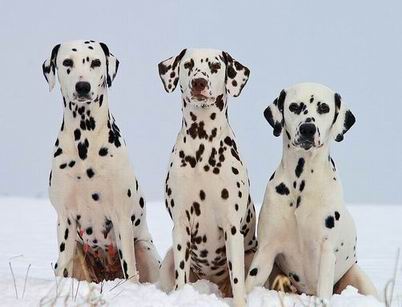
Dalmatian
Veterinarian Reviewed on December 22, 2007 by Dr. Janice Huntingford
Physical Characteristics
Breed Group:
Non-sporting / Utility
Weight:
45 – 70 pounds
Height:
19 – 24 inches
Color(s):
Dalmatians are famous for their white-with-black-spots coloring; liver spots can also occur.
Some rare colors include blue, orange, lemon, or merle spots.
Coat:
Dalmatians have short and fine coats. They shed year round and in considerably larger amounts compared to other breeds, so owners should be prepared to live in a rather hairy environment. However, despite the shedding, some people who are allergic to dogs have little to no symptoms around a Dalmatian.
Overview
Character:
An intelligent and athletic breed, the Dalmatian has been immortalized by the One Hundred and One Dalmatians stories. The soaring fame has unfortunately led to large numbers of abandoned Dalmatians when their independent and sensitive nature is mistaken for being difficult and un-trainable. If well-socialized and well-trained, Dalmatians are in fact loving and personable dogs that make excellent family pets.
Country of Origin:
Dalmatians are believed to have originated from Croatia, although this is disputed.
History:
The origin and history of the Dalmatian is highly disputed. Images of spotted hunting dogs have been found in ancient Egyptian paintings; along with other ancient artifacts depicting Dalmatians, these evidences have led to the conclusion that Dalmatians are a very ancient breed. They were believed to have originated from Croatia because they had accompanied traveling Roma in Europe. They were used as guards, eliminator of rodents, and carriage dogs that clear paths for horse-drawn carriages. This latter use transferred to Dalmatians being favored by firemen in the days of horse-drawn fire engines. To this day they remain the mascots of firehouses, particularly in the United States.
Name:
The name Dalmatian refers to their speculated origin, the Dalmatia province of Croatia.
Temperament:
Dalmatians are bred to be athletic, and therefore are very active and playful to the point of being rowdy at times. They need to be socialized at an early age, especially around children, so that they know how to behave and will not accidentally cause injuries during rough play. They are very social and people-loving, although they are more independent and therefore less willing to please than other breeds. They crave companionship and can get lonely if left by themselves for long periods of time.
Care
Training:
Dalmatians have an unfair reputation of being difficult to train. While they are certainly trainable, they are not beginners’ dogs. Their sensitive nature requires gentle but consistent corrections, since harsh treatments can break their spirit and produce a fearful dog. Training Dalmatians can take considerable amount of time and patience because of their rambunctiousness. A thorough understanding of dog psychology and experience are keys to properly train a Dalmatian.
Activity:
Because Dalmatians were bred to run alongside horses, they have very high stamina and energy. They require lots of exercise, and are happy to join their owners in long runs. A fenced yard is recommended for this highly active breed.
Ownership:
Dalmatians have a genetic disposition to deafness. Puppies can be tested for deafness as early as five weeks; nevertheless, Dalmatians with hearing problems can still make fine pets. Other potential health problem includes hyperuricemia, usually seen in middle-aged males; like hyperuricemia in humans, healthy diets can help reduce the symptoms such as gout and bladder stones.
Breeders
No breeders listed at this time.
Sign up for our newsletter and receive more articles and the latest pet health updates and special offers.
Our Expert
 Dr. Janice Huntingford
Dr. Janice HuntingfordJanice Huntingford, DVM, has been in veterinary practice for over 30 years and has founded two veterinary clinics since receiving her Doctor of Veterinary Medicine at the Ontario Veterinary College, University of Guelph. She has studied extensively in both conventional and holistic modalities. Ask Dr. Jan

